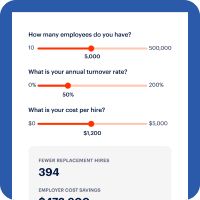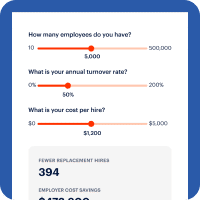The following article is another in our series that examines average employee turnover rates by industry.
In this article, we hold the retail industry under a microscope to see what might be affecting employee turnover and retention rates, and why employees in this industry are seen coming and going so often.
High turnover rates in the retail industry can get in the way of success and outstanding customer service. Turnover disrupts the quality of service, adds expenses to a business’s bottom line and can impact overall workplace morale.
In 2022, the annual average total separations rate for the retail industry was 5% compared to 3.9% across all industries, according to the U.S. Bureau of Labor Statistics.1
To complicate matters for retail companies, almost half of frontline retail employees surveyed said they are thinking about leaving their jobs, according to a 2022 McKinsey study.2 Considering around 20% of US employees—approximately 31 million people—work in the retail and hospitality sector, this mindset represents a potentially massive turnover issue.3
Retailers face high turnover rates and a competitive labor market, complicating recruiting and retaining employees.
Want to learn more about how DailyPay helps retailers attract and retain employees and boost productivity?
The Negative Impacts of High Turnover
Low employee retention can negatively impact workplace culture and team bonding, reduce the overall company knowledge base, harm customer service, and rack up a variety of costs which may include:
- Departure costs: Time dedicated to determining the last pay, severance benefits, and securing equipment such as company computers or tools.
- Lost production: Gaps in production or project progress when experienced staff members leave. Customer service and sales can also suffer when employees who were knowledgeable and engaged with clients and prospects depart.
- Overtime costs: A loss in production may lead to overtime expenses as more experienced staff fill in gaps.
- Recruiting costs: This may include hiring a recruiting firm or advertising service to find a replacement, selecting interview candidates, conducting interviews, handling background checks, and testing.
- Onboarding and training costs: Processing new employee data, integrating data into payroll and benefits systems, and training new workers on tactical job requirements, company policy, and culture.
Causes of High Turnover in Retail
According to a 2022 survey conducted by McKinsey, the top five reasons why retail employees leave their jobs include:4
- Workplace flexibility
- Career development
- Health and well-being
- Compensation
- Meaningful work
How to Reduce High Turnover in Retail With an Employee Retention Strategy
Every company needs to know its employee turnover rate. This is a great starting point as the rates vary even within the industry. This will help to project the savings and also break down the types of turnover which can be voluntary, involuntary and retirement. Once the turnover rate is known, there are some strategies that can be applied to reduce it.
Competitive Pay
Attractive and competitive pay not only involves how much an employee gets paid but how often. Fifty-nine percent of employed Americans, including 70% of hourly workers, say they would benefit from getting paid more frequently than they currently do.5
Better access to earned wages through on-demand pay helps employees manage and overcome their financial stress, avoiding negative effects on productivity and morale. Sixty-seven percent of users say DailyPay has helped them reduce financial stress.6
Outstanding Employee Benefits
Eighty-seven percent of employed Americans say it is at least somewhat important that their employer offers a retirement savings program, such as a 401(k) account.7
In addition to the standard benefits package that employees expect, a comprehensive benefits package that goes above and beyond competitors will give a hiring edge and contribute to employee appreciation and retention.
Offering on-demand pay as a benefit can help employers better serve their employees.
Support Employee Wellness
Employees are looking for ways to improve their work/life balance and reduce their stress levels. When employees are dealing with personal or financial stress, they may perform their job poorly or with less efficiency.
Employers can further help employees through financial wellness support. This can include personalized financial counseling, financial education courses, debt reduction programs and support groups.
Additionally, companies can offer employee wellness programs that include fitness perks, support work-life balance and more.
Employee Growth and Development
Supporting employees in their career growth and development will help set them up for success.
According to a 2021 Gallup report, 48% of American workers would switch to a new job if it offered skills training opportunities, and 65% of workers believe employer-provided upskilling is very important when evaluating a potential new job.8
Employers should consider how they can assist employees in upskilling and progressing their careers within the company instead of pursuing outside opportunities to further their careers including leadership training courses and classes.
Rewards and Recognition
Recognizing an employee for their hard work can play an important role in motivating and retaining employees.
According to the Harvard Business Review, recognition can significantly increase intrinsic motivation, performance and retention rates.9
Employers should consider how to improve their reward and recognition programs with meaningful rewards that tangibly help employees.
Recognize and incentivize employees with cash rewards in real-time with Reward by DailyPay. Reward helps employers to leverage the power of DailyPay to increase retention and engagement even further while driving behaviors that matter most to your business.
Support Retail Staff and Increase Retention With On-Demand Pay
It’s important for employers to align their retention strategies with employees’ expectations.
Employers must invest in their employees with valuable pay and benefit packages, opportunities for career growth and more flexibility in their work to increase engagement and employee happiness. In retail businesses, higher levels of employee happiness and engagement lead to better customer retention.10
Retail employers should consider enticing employees with benefits other than increased pay, as even the proposed federal minimum wage of $15/hour is not attractive enough to entice applicants to open jobs, according to research conducted by Mercer.11
According to a DailyPay sponsored survey done by the Mercator Advisory Group, the annualized improvement in turnover rate in the retail industry was 24% for employees who use DailyPay vs. those who don’t.12
Learn how DailyPay can help.
FAQs
-
What was the 2022 trend for turnover rates in the retail industry?
According to a November 2022 analysis, the retail industry turnover rate was 75.8% for all hourly, in-store positions.6
-
Are retail industry turnover rates higher compared to other industries?
The 2021 separation rate for retail was 64.6% compared to a national average of 47.2% across all industries.7
-
How can retail companies combat high turnover rates?
Retail companies can increase compensation and financial wellness benefits such as on-demand pay to entice workers to remain at their company.8
-
How did the pandemic affect retail turnover?
Although retail turnover is traditionally high compared to the national average, there has been an even greater discrepancy between retail turnover in 2020 and 2021 and the national average in those years.9
-
What was the average retail turnover rate in 2022?
The BLS publishes annual turnover numbers in March of the following year, with 2022 stats expected in early March 2023. The retail turnover rate in 2020 was 69.6% and in 2021 it was 64.6%.10
All information herein is for educational purposes only and should not be relied upon for any other use. The information herein does not constitute the rendering of professional advice by DailyPay. DailyPay does not warrant the completeness or accuracy of any information provided to you.
1 https://www.bls.gov/news.release/jolts.t20.htm:DailyPay, 2020
2 https://www.mckinsey.com/industries/retail/our-insights/how-retailers-can-attract-and-retain-frontline-talent-amid-the-great-attrition:DailyPay, 2020
3 https://www.mckinsey.com/industries/retail/our-insights/how-retailers-can-attract-and-retain-frontline-talent-amid-the-great-attrition:DailyPay, 2020
4 https://www.mckinsey.com/industries/retail/our-insights/how-retailers-can-attract-and-retain-frontline-talent-amid-the-great-attrition:DailyPay, 2020
5 Harris Poll Consumer Finances study commissioned by DailyPay and Funding Our Future, 2021 :DailyPay, 2020
6 November 2022 DailyPay User Survey :DailyPay, 2020
7 Harris Poll Consumer Finances study commissioned by DailyPay and Funding Our Future, 2021:DailyPay, 2020
8 https://www.gallup.com/analytics/354374/the-american-upskilling-study.aspx:DailyPay, 2020
9 https://hbr.org/2021/03/research-a-little-recognition-can-provide-a-big-morale-boost:DailyPay, 2020
10 https://www.nasdaq.com/articles/4-reasons-why-happy-employees-are-good-for-your-bottom-line:DailyPay, 2020
11 https://www.marshmclennan.com/insights/publications/2021/september/retail-talent-shortage-or-labor-shift.html:DailyPay, 2020
12 https://www.dailypay.com/mercator-report-2021/:DailyPay, 2020














